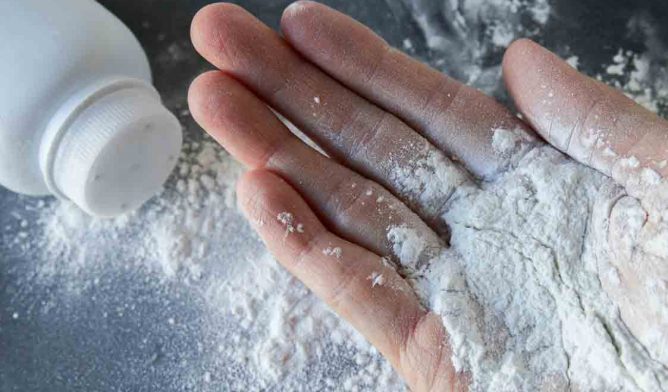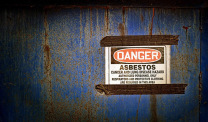Case Study Shows Asbestos in Talc Causes Mesothelioma
Asbestos Exposure & BansWritten by Tim Povtak | Edited By Walter Pacheco

Prolonged exposure to asbestos-contaminated talcum powder has led to malignant mesothelioma cancer, according to an extensive case study by a leading occupational medicine and epidemiology organization.
The study examined 33 mesothelioma patients, mostly women, whose only significant exposure to asbestos involved cosmetic talc.
Researchers believe they found a definitive link.
The Journal of Occupational and Environmental Medicine published the study earlier this month, detailing six individuals who underwent tissue testing that revealed asbestos fibers consistent with those found in talc.
Exposure to asbestos is the primary cause of mesothelioma, a rare and aggressive cancer diagnosed in an estimated 3,000 people annually in the United States.
“Everything points to cosmetic talc being the cause,” co-author Dr. Jacqueline Moline told Time Magazine. “This is the first time that anyone has said, ‘Let me look at all these cases, put it together and identify the ones where [talc] is the sole exposure.’”
Moline is a professor in the department of Occupational Medicine, Epidemiology and Prevention at the Feinstein Institutes for Medical Research of Hofstra University School of Medicine in Hempstead, New York. She declined to speak directly with The Mesothelioma Center at Asbestos.com.
“People aren’t even aware that cosmetic talcum powder might have asbestos in it,” Moline said. “Anything you use on your body, or in your body, you want to be careful about.”
On Friday, consumer goods giant Johnson & Johnson announced a voluntary recall of a “single lot” (#22318RB) of its iconic Johnson’s Baby Powder in response to testing by the U.S. Food and Drug Administration that found trace amounts of chrysotile asbestos contamination in the product.
Asbestos and Talc Often Mix
The issue of asbestos contamination in talc stems from the mining process of the two naturally-occurring minerals, which are often found in close proximity on the earth’s surface.
Methodologies for testing talc for asbestos fibers are complex and have been debated for years. Often the science has been inconclusive, complicating the recent surge of litigation involving ovarian cancer allegedly caused by talcum powder products.
Asbestos-contaminated talc also has been identified in crayons, children’s toys and makeup products.
The relationship between occupational exposure to asbestos and mesothelioma is well established and much easier to pinpoint decisively.
The purpose of this recent study was to help explain the growing prevalence of mesothelioma among people — particularly women — who had no occupational exposure to the toxic mineral.

If you think you were exposed to asbestos using talc, we can help match you with an attorney. Get the compensation you deserve.
Get Help NowCases Come from Litigation
The 33 mesothelioma cases used in the study were based on medical records and deposition transcripts from legal proceedings. Exposure data was obtained from sworn testimony and extensive occupational and hobby histories.
Talcum powder histories included type used, duration of use and age at first use.
Ronald E. Gordon, Department of Pathology, Icahn School of Medicine at Mount Sinai Hospital, was another co-author of the study.
Both Moline and Gordon have served as plaintiff witnesses in litigation involving mesothelioma and ovarian cancers allegedly caused by contaminated talc.
As part of tort litigation, Gordon took tissue samples from the six patients who were detailed in the study. None of the six patients identified any asbestos exposure from workplace or household environments.
Asbestos Found in Tissue Each Time
Tissue samples in all six cases revealed the presence of talc, aluminum silicates, silica crystals and asbestos fibers in the anatomic vicinity of the mesothelioma tumor cells.
The asbestos fibers found were all of the tremolite, chrysotile or anthophyllite variety, which have been identified previously in select laboratory testing of talcum powders. No amosite or crocidolite fibers — more commonly found commercially — were found.
The six tissue samples also were compared to background control samples of tissue obtained from surgical samples or at autopsy from patients without mesothelioma who had no history of occupational exposure.
The comparisons were revealing. Only 17% of the control samples showed any evidence of non-commercial asbestos fibers. The asbestos burden in all six of the talc-lawsuit samples was greater than any of those in the control group.
No aluminum silicates or silica crystals, all part of the talcum powder identified in the mesothelioma patients, were found in the control group that had not used talcum powder.
This study was the first large case series to identify contaminated cosmetic talc as the cause of mesothelioma and the first to use background controls dictated by no known asbestos exposure.
It emphasizes the continued risk from common cosmetic products once thought to be safe for all.
“I would tell people that there is no regulation for talc, and that if there is a safer alternative, than I would advise them to do that,” Moline said. “I would not recommend people use talcum powder.”






